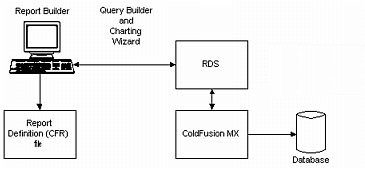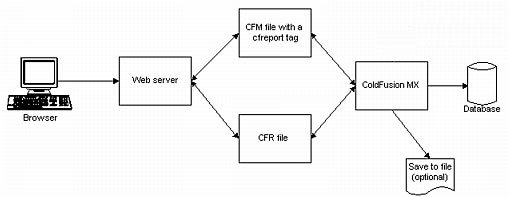
The Report Builder is a stand-alone application that creates report definitions, interacting with a ColdFusion MX server, as necessary. The major architectural components are as follows:
Note: The Report Builder runs in the Windows platform only. However, the CFR files created by the Report Builder run on all platforms that ColdFusion MX runs on and that have ColdFusion MX Reporting enabled.
The Report Builder stores report definition information in a ColdFusion Report (CFR) file. This file contains field definitions, formatting, database SQL statements, CFML, and other information. You display a CFR file using the cfreport tag and, if enabled for the report, you can display the report by invoking the CFR file in a browser.
Remote Development Services (RDS) is a proprietary protocol that uses HTTP to enable the Query Builder and Chart Wizard to access database data through a ColdFusion data source. To enable this functionality in the Report Builder, you define settings for an RDS server. RDS server is another name for an associated ColdFusion server that has enabled RDS.
The following figure shows the interaction of the Report Builder, CFR files, and RDS:

For more information, see Configuring RDS.
At runtime, you invoke the CFR file using a ColdFusion MX server that has ColdFusion MX 7 Reporting enabled. For more information on enabling ColdFusion MX reporting, see Getting started.
You can display the CFR file directly or invoke it through the cfreport tag. Additionally, you can optionally save the report to a file instead of returning output to the browser. The following figure shows the ColdFusion MX reporting runtime architecture:

If the report requires input parameters or a passed query, you must use the cfreport tag. If you pass a query attribute in the cfreport tag, it overrides any internal SQL statement in the report definition.